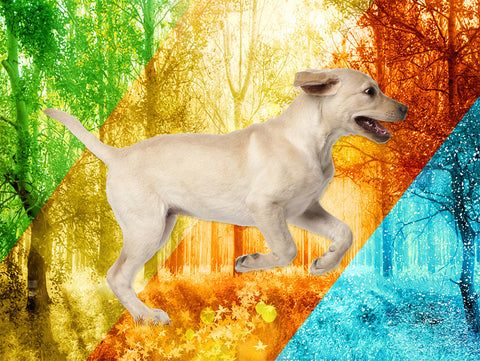Seasonal Care for Dogs: Preparing Your Pup for Weather Changes.
Share
Seasonal changes can significantly impact your furry friend's lifestyle which can cause emotional upheaval. You’ll need to adapt their care routine to meet the changing weather better.
Whether you're transitioning from summer to fall or winter to spring, understanding how to prepare your dog will help things easier for everyone in the household.
Prepare Your Dog for All Seasons

Here's a guide to seasonal care for dogs. With these tips, you can keep Fido healthy, comfortable, and happy throughout the year.
Transitioning to Fall
As the leaves change color and the air gets crisper, it's time to adjust your dog's routine accordingly.
As temperatures drop, you’ll want to ensure that your pup has a warm, cozy place to sleep. Place the doggy bed away from drafts.
Does your pooch spend lots of time outdoors? If so, you’ll want to reduce their outdoor time as the weather starts to dip.
Some dogs spend a great deal of time outdoors. If this is the case, you’ll want to provide a dog house or some other shelter where your dog can seek refuge from cold temperatures, wind, rain, and snow.
Diet changes may also be necessary with the approach of fall. Some dogs are less active in cooler weather, which can lead to weight gain.
Monitor your pet's activity level and adjust their calorie intake accordingly.
Even though there is a drop in temperature, the flea and tick population can still thrive so be sure to continue with your dog’s flea and tick prevention to keep the parasites away.
Welcoming Winter

Winter demands special attention to your dog's needs. Cold, ice, and salt can all pose risks, so consider doggy booties or paw wax to protect your furry friend’s paws.
After walks, always take the time to, wipe your dog's feet to remove any salt or harmful chemicals that can cause irritation or be ingested during grooming.
Indoor exercise becomes more critical during the colder months. Keep your dog active and engaged with indoor games or short, more frequent walks.
Watch for signs of discomfort or reluctance to go outside, as these can indicate your dog is feeling too cold.
Springing into Spring
As the snow melts and temperatures rise, it's time to prepare for spring. This season is often wet, so be ready with waterproof gear for rainy walks.
Spring is also when fleas, ticks, and heartworms become more prevalent, so visit your pet’s veterinarian to ensure your dog is up-to-date on preventative medications.
Allergies can also flare up in spring. Monitor your dog for any signs of discomfort, like scratching, biting, or sneezing, and consult your vet if you suspect they're suffering from allergies.
Summertime Care
Heat and humidity are the main concerns in summer. Always provide plenty of fresh, cool water and shade for your dog.
Avoid walking your dog during the hottest parts of the day, and never leave them in a parked car, even for a short time.
Consider your dog's breed and coat type when it comes to grooming. Some dogs benefit from a summer trim to help them stay cool, while others need their full coat to protect their skin from the sun.
Year-Round Tips
Regardless of the season, regular vet check-ups are vital to monitor your dog's health and address any issues early.
Keep a consistent routine, as dogs thrive on predictability, and be mindful of your dog's age, breed, and health status, as these can affect how they respond to weather changes.
By being attentive and proactive, you can help your dog better cope with the many challenges each season brings.



